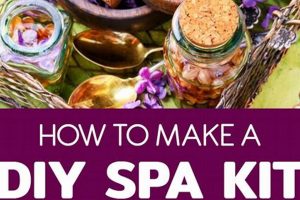A collection of pre-measured ingredients and tools designed for crafting effervescent bath products at home. Such sets typically include a combination of dry components like baking soda, citric acid, Epsom salts, and cornstarch, along with liquid elements such as essential oils, coloring agents, and binding oils. Molds in various shapes may also be provided to form the final product. For example, a common assortment might contain baking soda, citric acid, lavender essential oil, purple dye, and spherical molds.
These sets provide a convenient and accessible avenue for individuals to create customized bathing experiences. The advantage lies in the ability to control the ingredients, ensuring a final product that aligns with personal preferences and sensitivities. Historically, the creation of these items was often a complex process involving precise measurements and sourcing individual components; these kits streamline this undertaking, making it more manageable for a wider audience. Benefits include stress reduction through aromatherapy, skin moisturization, and the enjoyment of a personalized spa-like experience.
The subsequent discussion will delve into the specific components typically found within these sets, offering guidance on selection criteria and safety considerations, and illustrating the creative potential inherent in crafting personalized bath amenities.
Crafting Excellence
Achieving optimal results when utilizing a do-it-yourself bath bomb kit requires attention to detail and adherence to best practices. The following guidelines are intended to enhance the user experience and ensure the creation of high-quality bath products.
Tip 1: Adhere to Precise Measurements: The chemical reaction responsible for the fizzing action is dependent on the correct ratio of dry ingredients, typically baking soda and citric acid. Deviations from the recommended proportions can result in a weak reaction or premature activation.
Tip 2: Incorporate Liquids Sparingly: Excessive moisture can trigger the fizzing process prematurely. When adding essential oils, coloring agents, or water, introduce these components gradually using a spray bottle to control the level of saturation.
Tip 3: Thoroughly Combine Ingredients: Ensure that all dry ingredients are uniformly distributed before introducing any liquids. Incomplete mixing can lead to inconsistent texture and uneven fizzing properties in the final product.
Tip 4: Pack Molds Tightly: Firmly compress the mixture into the molds to eliminate air pockets. This will produce a denser, more durable product that is less prone to crumbling. Overfill the molds slightly and then level off the excess before unmolding.
Tip 5: Allow Adequate Drying Time: Once unmolded, allow the creations to dry completely in a cool, dry environment for at least 24 hours, or preferably longer, depending on humidity levels. This hardening process is crucial for maintaining the structure and integrity of the bath product.
Tip 6: Consider Added Ingredients with Caution: While personalization is encouraged, adding ingredients beyond those provided in the kit should be approached with discretion. Certain substances, such as fresh botanicals or coarse salts, can introduce excess moisture or interfere with the chemical reaction.
Tip 7: Prioritize Safety Precautions: When handling powdered ingredients and essential oils, it is recommended to wear protective gloves and eyewear to prevent skin and eye irritation. Work in a well-ventilated area to minimize inhalation of dust.
By implementing these recommendations, individuals can maximize the potential of the do-it-yourself bath bomb kit and produce professional-quality bath amenities. The attention to detail during each step of the process is essential for ensuring a satisfying and enjoyable bathing experience.
The subsequent section will address potential challenges encountered during the creation process and provide troubleshooting strategies for resolving common issues.
1. Ingredient selection
Ingredient selection is a foundational aspect of crafting effective and personalized bath products through a do-it-yourself bath bomb set. The composition directly influences the final product’s performance, therapeutic properties, and suitability for individual skin types. Therefore, careful consideration of each component is essential.
- Base Components: Sodium Bicarbonate and Citric Acid
These are the primary reactive elements responsible for the effervescent action. The ratio between the two must be precisely balanced to achieve optimal fizzing. An imbalance can result in either a weak reaction or premature activation, rendering the bath bomb ineffective.
- Binding Agents: Oils and Water
A binding agent is necessary to hold the dry ingredients together, forming a cohesive structure. Oils, such as coconut or almond oil, offer moisturizing benefits, while water, when used sparingly, activates the citric acid. Over-saturation can prematurely initiate the fizzing reaction, leading to a suboptimal final product.
- Additives: Essential Oils and Colorants
Essential oils provide fragrance and potential therapeutic benefits through aromatherapy. The selection should align with the intended purpose, such as lavender for relaxation or eucalyptus for invigoration. Colorants, either natural or synthetic, add visual appeal. The concentration of both additives should be controlled to avoid skin irritation or staining.
- Emollients and Additional Actives: Epsom Salts and Botanicals
Epsom salts can be included for their purported muscle-relaxing properties. Botanicals, such as dried flower petals, can add visual interest and potentially offer skin-soothing benefits. However, these additions must be carefully considered, as they can sometimes introduce excess moisture or interfere with the primary chemical reaction.
The judicious selection of ingredients within a do-it-yourself bath bomb set allows for customization and control over the final bath experience. By understanding the role of each component and its potential impact, users can create bath bombs that are both effective and tailored to their specific needs and preferences, achieving a synergistic balance between effervescence, aroma, and therapeutic benefits.
2. Fizzy activation
The effervescent reaction, commonly referred to as “fizzy activation,” represents a core functional attribute of a do-it-yourself bath bomb kit. This reaction is responsible for the visual and sensory experience associated with the product’s use, and its effectiveness directly impacts user satisfaction. Understanding the mechanisms that govern this activation is crucial for successful formulation and utilization of these kits.
- Acid-Base Reaction
The primary chemical reaction involves the interaction of a weak acid, typically citric acid, and a base, usually sodium bicarbonate (baking soda). In the presence of water, these compounds react to produce carbon dioxide gas, which manifests as bubbles. The ratio of these components within the set directly influences the intensity and duration of the fizzing effect. An imbalance can lead to either a weak or excessively rapid reaction.
- Role of Water
Water acts as the catalyst for the acid-base reaction. The degree of moisture control during the mixing and molding phases is paramount. Excessive water content can prematurely trigger the reaction, resulting in a loss of effervescence before the bath bomb is fully formed and dried. Conversely, insufficient moisture may hinder the reaction upon submersion in bathwater, leading to a lackluster performance.
- Influence of Binding Agents
Binding agents, such as oils or starches, are incorporated to hold the dry ingredients together. These agents can indirectly influence the rate and nature of the fizzing action. For instance, oils can create a hydrophobic barrier, potentially slowing down the initial water penetration and resulting in a more controlled, prolonged release of carbon dioxide. Conversely, excessive starch can absorb moisture and dampen the reaction.
- Temperature Effects
The temperature of the bathwater can affect the rate of the chemical reaction. Warmer water generally accelerates the reaction, leading to a more vigorous fizz, while cooler water may slow it down. Consequently, variations in bathwater temperature can lead to inconsistencies in the perceived effectiveness of the bath bomb.
The successful utilization of a do-it-yourself bath bomb kit hinges on a thorough understanding of the factors influencing fizzy activation. By carefully controlling the ratios of reactants, moisture levels, and additives, and by considering the temperature of the bathwater, users can optimize the performance of their homemade bath bombs, ensuring a satisfying and enjoyable bathing experience. The manipulation of these parameters allows for customization of the sensory experience, catering to individual preferences for fizz intensity and duration.
3. Aromatic infusion
The integration of fragrance, termed “aromatic infusion,” is a key component in the creation of personalized bath products using a do-it-yourself bath bomb kit. The selection and application of scents contribute significantly to the overall sensory experience and potential therapeutic benefits derived from the bath.
- Essential Oil Selection and Concentration
Essential oils serve as the primary source of fragrance in these products. The choice of oil dictates the aromatic profile and may provide targeted effects, such as relaxation (lavender), invigoration (peppermint), or stress relief (chamomile). The concentration of essential oil is critical; excessive amounts can cause skin irritation, while insufficient quantities may result in a weak or imperceptible scent.
- Fragrance Blending and Compatibility
Complex aromatic profiles can be achieved through blending multiple essential oils. However, careful consideration must be given to the compatibility of scents. Certain combinations may produce undesirable or clashing aromas. Researching fragrance families and their synergistic properties is essential for creating harmonious blends.
- Encapsulation and Release Mechanisms
The method by which the fragrance is incorporated and released during the bath affects the duration and intensity of the aromatic experience. Direct incorporation into the dry mixture may result in rapid diffusion and a short-lived scent. Encapsulation techniques, such as using specialized beads or powders, can provide a more controlled and sustained release.
- Impact of Other Ingredients on Scent Profile
The other components of the bath bomb, such as oils and colorants, can influence the perceived fragrance. Carrier oils, for instance, may have their own subtle scent that interacts with the essential oils. Similarly, certain colorants can alter the perceived intensity or character of the fragrance.
The effective aromatic infusion within a do-it-yourself bath bomb kit requires a nuanced understanding of scent selection, blending techniques, and the influence of other ingredients. By carefully managing these factors, users can create bath products that deliver a customized and therapeutically beneficial aromatic experience. The resulting product not only cleanses the body but also engages the senses, promoting relaxation and well-being.
4. Mold complexity
The term “mold complexity” in the context of a do-it-yourself bath bomb kit refers to the intricacy of the shape and design of the mold used to form the bath bomb. This facet directly influences the aesthetic appeal and perceived value of the final product. A simple spherical mold, for instance, offers ease of use and consistent results. Conversely, molds with detailed patterns, multiple components, or undercuts present greater challenges during the packing and unmolding processes. The selection of mold complexity inherently impacts the time investment and skill level required for successful bath bomb creation.
Molds featuring complex geometries can introduce potential problems. Undercuts or fine details can trap the bath bomb mixture, leading to breakage or incomplete release. Multi-part molds, while enabling intricate designs, demand precise alignment and secure fastening to prevent leakage or distortion during drying. The material of the mold whether plastic, metal, or silicone also affects the unmolding process. Silicone molds are generally more flexible and allow for easier release, while rigid molds may require tapping or gentle manipulation. For example, a kit featuring a mold with floral patterns will likely necessitate more careful packing and unmolding than a kit with simple round molds to prevent damage to the delicate petal shapes.
In conclusion, the degree of mold complexity represents a crucial consideration when evaluating a do-it-yourself bath bomb kit. While intricate designs offer greater aesthetic potential, they also increase the difficulty and risk of failure during the crafting process. Consumers should carefully assess their skill level and available time when selecting a kit, weighing the desired visual outcome against the practical challenges posed by complex molds. A balanced approach ensures both creative satisfaction and successful product creation.
5. Binding efficacy
Binding efficacy, the ability of an ingredient to coalesce the dry components of a bath bomb into a stable, cohesive structure, is paramount to the success of any do-it-yourself bath bomb kit. Inadequate binding results in crumbling, premature activation, or structural instability, negating the user’s efforts and undermining the intended bathing experience.
- Role of Liquid Binders
Liquid binders, typically oils (e.g., coconut, almond) or water, serve as the primary agents for adhering dry ingredient
s. Oils contribute emollient properties and slow down the fizzing reaction upon contact with bathwater, while water activates the citric acid. The optimal amount of liquid binder is crucial; too little results in a fragile structure, and too much triggers premature fizzing and expansion, leading to a deformed final product. For example, a mixture with insufficient oil will crumble easily, whereas a waterlogged mixture may expand and crack during drying. - Impact of Powdered Binders
Powdered binders, such as cornstarch or tapioca starch, can supplement liquid binders by absorbing excess moisture and providing additional structural support. These ingredients create a more uniform texture and enhance the overall cohesiveness of the bath bomb. However, overuse of powdered binders can inhibit the fizzing reaction by creating a dense matrix that restricts water penetration to the reactive components. A balanced formulation is essential to ensure both structural integrity and effervescence.
- Influence of Ingredient Particle Size
The particle size of the dry ingredients significantly impacts binding efficacy. Fine powders create a smoother, more uniform mixture with greater surface area for adhesion, leading to a more robust final product. Coarse ingredients, such as large salt crystals, can disrupt the binding process and create weak points in the structure. Grinding coarse ingredients to a finer consistency can improve binding and overall structural integrity.
- Effect of Mixing Technique
Proper mixing technique is crucial for ensuring uniform distribution of the binding agents. Inadequate mixing results in localized areas of weakness, where the dry ingredients are not adequately adhered. Thorough, even mixing ensures that the binding agents are distributed throughout the mixture, promoting cohesive bonding and a structurally sound bath bomb. For example, layering ingredients without thorough mixing will lead to uneven binding and a structurally weak bath bomb.
The interplay of these factors significantly influences the outcome of a do-it-yourself bath bomb creation. A carefully balanced formulation, incorporating appropriate liquid and powdered binders, coupled with proper mixing techniques, ensures optimal binding efficacy, resulting in a structurally sound, effervescent, and enjoyable bathing experience.
6. Color diffusion
Color diffusion, the dispersion of coloring agents within a bath environment, constitutes a significant aesthetic component of the do-it-yourself bath bomb kit experience. The manner in which color permeates the water influences the perceived quality and enjoyment of the product. Predictable and visually appealing color diffusion is a direct result of the choice of colorant, its concentration, and the formulation of the bath bomb itself. For instance, improperly dispersed colorant may result in streaking or concentrated pockets of color, detracting from the intended visual effect. Achieving even color diffusion relies on factors such as using water-soluble dyes, ensuring thorough mixing of colorants during manufacture, and considering the impact of other ingredients (e.g., oils) on dye solubility. A bath bomb intended to create a swirling effect, for example, employs multiple colors placed strategically to interact during dissolution, demonstrating a purposeful manipulation of color diffusion.
The selection of appropriate colorants is crucial for both aesthetic appeal and safety. Natural colorants, derived from plants or minerals, may offer subtle hues but can be less predictable in their diffusion and stability compared to synthetic dyes. Synthetic dyes, while offering a wider range of vibrant colors, necessitate careful consideration of regulatory compliance and potential skin sensitivities. In practice, manufacturers of these kits must balance the desire for intense color with the need for product safety and stability. The interaction between the bath bomb’s effervescent action and the release of colorants is a key element; the fizzing helps disperse the color throughout the water, and the rate of dissolution affects the overall intensity and pattern of color diffusion.
In summary, understanding and controlling color diffusion is essential for creating visually appealing and commercially viable bath bombs. The success of a do-it-yourself bath bomb kit depends not only on its ability to cleanse and provide aromatherapy but also on its capacity to transform the bathwater into a visually stimulating and relaxing environment. Challenges arise in maintaining color vibrancy and stability across various water temperatures and pH levels, highlighting the need for careful ingredient selection and formulation expertise. Achieving optimal color diffusion aligns with the broader goal of enhancing the overall sensory experience associated with bath bomb usage.
7. Drying duration
Drying duration, within the context of a do-it-yourself bath bomb kit, represents the interval required for newly molded bath bombs to achieve sufficient hardness and stability post-production. This period is critical because premature handling or packaging can result in damage, deformation, or premature activation of the fizzing reaction. The chemical process occurring during this time involves the evaporation of excess moisture from the mixture, which allows the binding agents to solidify and maintain the bath bomb’s intended shape. Insufficient drying leads to a fragile product that crumbles easily, rendering it unusable. For instance, attempting to package a bath bomb after only a few hours of drying may result in significant breakage, especially if the mixture was slightly over-saturated during preparation.
The ideal drying duration varies based on environmental conditions, formulation, and mold geometry. Higher humidity levels prolong the drying process, while a dryer environment accelerates it. Formulations with excessive liquid binders or hygroscopic ingredients (e.g., certain salts) require extended drying times. Additionally, bath bombs molded in complex shapes with intricate details may need longer drying periods to ensure complete solidification in all areas. Practically, allowing a drying period of at least 24-48 hours in a cool, dry location is generally recommended for most DIY bath bomb kits. This extended period mitigates the risk of damage during handling, maintains product integrity, and ensures a satisfying end-user experience. Factors to consider include the mixture was too wet or the mold is very deep, it would benefit from an even longer time to dry out.
In summary, the careful management of drying duration is an indispensable step in the creation of stable, functional bath bombs using DIY kits. The primary challenges involve balancing the need for complete drying with the desire for efficient production and packaging. Failure to adhere to appropriate drying times can compromise product quality, resulting in consumer dissatisfaction and potential waste. Therefore, providing clear instructions and guidelines regarding drying duration is crucial for the success of any do-it-yourself bath bomb kit.
Frequently Asked Questions About DIY Bath Bomb Kits
The following questions address common inquiries and concerns regarding the proper use and understanding of do-it-yourself bath bomb sets. The information presented aims to provide clarity and improve the user experience.
Question 1: What are the primary components of a standa
rd do-it-yourself bath bomb kit?
A typical kit includes sodium bicarbonate (baking soda), citric acid, a binding agent (oil or water), coloring agent, fragrance (essential oil or fragrance oil), and molds. Some kits may also include Epsom salts, cornstarch, or dried botanicals.
Question 2: Why is the ratio of baking soda to citric acid critical?
The effervescent reaction that creates the fizzing effect depends on a precise ratio of these two components. Deviation from the recommended ratio can result in either a weak reaction or premature fizzing during production, reducing the bath bomb’s effectiveness.
Question 3: What is the optimal drying time for bath bombs created using these kits?
A minimum of 24 to 48 hours is generally recommended for complete drying. Drying time can be influenced by ambient humidity, the formulation of the bath bomb, and the size and complexity of the mold.
Question 4: How should coloring agents be incorporated to ensure even distribution?
Coloring agents should be mixed thoroughly with the dry ingredients before the addition of any liquid binders. This ensures a uniform color throughout the bath bomb and prevents streaking or uneven color distribution during use.
Question 5: What precautions should be taken when handling essential oils in these kits?
Essential oils should be handled with care, as they can cause skin irritation or allergic reactions in some individuals. It is advisable to use gloves during the mixing process and to avoid direct contact with skin and eyes. The concentration of essential oils should adhere to the kit’s instructions to minimize potential adverse effects.
Question 6: What are the potential causes of a crumbling bath bomb, and how can it be prevented?
Crumbling can result from insufficient binding agents, inadequate mixing, or premature handling before complete drying. Ensuring proper ingredient ratios, thorough mixing, and allowing sufficient drying time are essential preventive measures.
Careful adherence to the instructions and a clear understanding of the individual components contribute significantly to the successful creation of high-quality bath products using these kits.
The following section provides guidance on evaluating the safety aspects associated with the use of do-it-yourself bath bomb sets.
diy bath bomb kit
The preceding discussion has comprehensively examined the various facets of these sets, encompassing ingredient selection, the mechanisms of fizzy activation, aromatic infusion techniques, considerations regarding mold complexity, factors influencing binding efficacy, the dynamics of color diffusion, and the importance of drying duration. The successful utilization of these kits relies on a thorough understanding of these elements and a commitment to following the prescribed instructions.
Therefore, prospective users must prioritize safety precautions and carefully consider the potential risks associated with handling chemical compounds. A responsible approach ensures both a satisfactory and safe crafting experience. Continued adherence to established guidelines and ongoing research into best practices will further refine the utilization of these kits and enhance the overall quality of homemade bath amenities.







